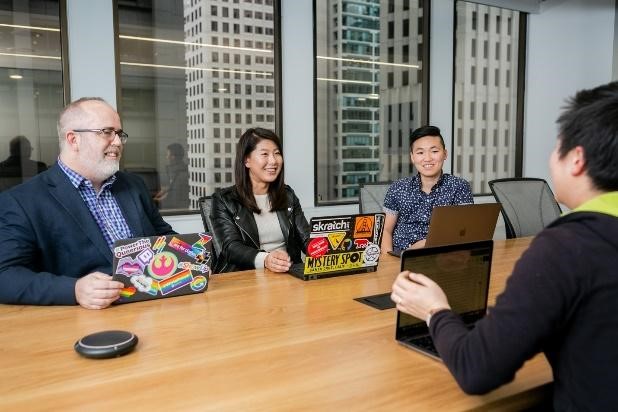
For the first time in history, the business environment includes a workforce that spans five generations. Due to evolving worldwide demographics, a generationally diverse labor market works side by side to achieve shared commercial and economic goals. Each generation has its communication and working styles, values, career goals, and perspectives.

What are the five workforce generations?
Silent generation – born between 1928 and 1945
This generation is currently the oldest member of the workforce. They lived through harsh social and economic conditions and grew up without modern conveniences and technology. The adversity that they overcame instilled in them the value of hard work and financial diligence.
Baby Boomers – born between 1946 and 1964
This “workaholic generation” grew up doing traditional forms of communication such as phone calls and letters. They are hardworking, competitive, and goal-oriented but usually socially reserved.
Generation X – born between 1965 to 1980
Sometimes considered the “middle child” between the boomers and Millennials, this generation is acknowledged for originating the work/life balance concept. They shun micromanagement since they are known to be self-sufficient and exceptionally independent.
Generation Y – born between 1981-1996
This generation is the largest of the workforce and is popularly referred to as millennials. They thrive on coming up with innovative ideas, which lead to the creation of the start-up culture. They are also excellent multitaskers and aim to work smart than work hard.
Generation Z – born between 1997-2015
The youngest generation in the labor market, this group grew up in the age of digital technology. They are also very creative and excellent at multitasking but are prone to distractions since they are always connected.
What problems can arise within a multigenerational workplace?
Problems inevitably arise in the workplace due to the differences across these generations. Clashing values and beliefs may lead to conflicts and interpersonal issues. When a dispute arises, productivity and engagement are adversely affected.
The age gap between employees can also lead to communication gaps and age discrimination. The exposure of the younger ones to technology and the older ones’ lack of it make communicating and working together on a project difficult.
Since each generation grew up in various social, cultural, economic, and political climates, it can be tough to relate to one another. Comparisons may ensue, which can elicit feelings of defensiveness or entitlement.
Managing a generationally diverse workplace can be very challenging. However, understanding each team members’ differences and what makes them tick are excellent first steps. Next would be to cultivate healthy workplace values to create a productive and united team.
What are the workplace values that can bring generational differences together?
Empathy
Dealing with coworkers of the same age can already be challenging—all the more with teammates or managers who belong to other age groups. The key to managing these differences is to practice empathy. It’s about stepping into another person’s shoes to be able to understand their perspectives and values.
Using collective labels and creating assumptions about each other also prevent coworkers from appreciating each other’s individualities. Using labels such as “tech-obsessed millennials” or “inflexible boomers” can cause a further rift among the team. You can achieve harmony by leaving your unconscious bias at the door and accepting each others’ unique contributions to the company.
Adaptability
Accommodating the needs and preferences of younger or older coworkers, as long as they are practical, can lead to a more smooth sailing relationship in the workplace. Seeing their points of view will be easier if you understand what makes them tick. Even if they do not match your perspective, welcoming suggestions can open a world of possibilities and new information for you.
There will be times when things in the workplace will not go as planned. Try to find the cause and correct resolution to avoid it from happening again and see something positive in the outcome. When you change your mindset, it will be easier to look at the bright side of things.
Respect at Workplace
No matter the age or experience, respect for each other is the foundation of any positive workplace environment. The younger generations need to respect the older ones’ wisdom and seniority. Likewise, the senior employees need to respect the potential and talents of junior team members.
The key to cultivating a culture of respect is understanding each other’s values and accepting that they are different from yours. Try to get a better look at their life experiences, working styles, and motivations. Perhaps, you can get inspiration and lessons along the way.
Communication
There is a wide gap between the communication styles of each generation. For example, Gen Z usually relies on instant messaging to communicate, while Boomers prefer emails or phone calls. It would be best to adapt your communication to the other person’s preferred mode of delivery to avoid having problems.
Active listening is also a part of effective communication. Try to avoid assuming what your team needs. Listen—not just hear—what the members have to say and use their insights to devise a plan to improve workplace engagement.
Collaboration and teamwork at Workplace

It would be great to assemble age-diverse teams for projects. It can help leverage each generation’s unique skills, talents, and insights and encourage them to cooperate. It can be a wonderful mix of ideas- technological innovations from Gen Y and Z and expert industry insights from the silent generation and boomers.
Collaboration can also lead to a healthy exchange of ideas. Each generation has unique stories to tell and knowledge to impart. The success of multigenerational teams relies on identifying, valuing, and building on one another’s experiences and skills. Focusing on individual strengths rather than the differences is a crucial part of creating a thriving work environment.
Celebrating Generational Diversity is the Future of the Workplace
A multigenerational workplace can be a strong force that sparks creativity and drives innovation. The beauty of age diversity lies in having a rich source of varied perspectives, experiences, backgrounds, and skills.
Often, these qualities complement each other and can be an excellent avenue for team bonding, collaboration, and mentorship. When there is a harmonious relationship within the workplace, there is a high level of engagement and productivity.
Also Read : Walmart Call Out Number

Leave a Reply